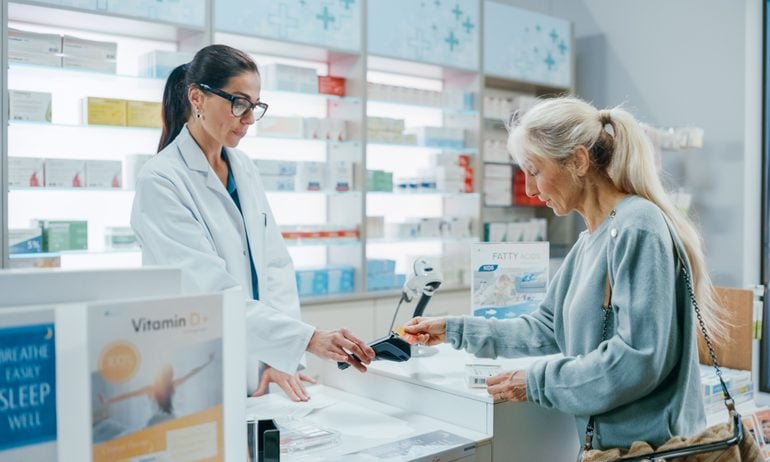3 Options That Could Help With Mounting Medicare Part D Costs
Government programs, private charitable foundations and a new law going into effect might offer relief from high prescription drug costs.

Many, or all, of the products featured on this page are from our advertising partners who compensate us when you take certain actions on our website or click to take an action on their website. However, this does not influence our evaluations. Our opinions are our own. Here is a list of our partners and here's how we make money.
More than one in five adults age 65 and older reported not taking medications as prescribed due to cost, according to a 2023 study published in JAMA Network Open.
There’s help available, but many beneficiaries might not be aware of their options.
“Far too many people don’t know that there are resources out there to help them,” says Amy Niles, chief mission officer at the PAN Foundation, a nonprofit organization that helps people get needed prescription drugs and medical treatments.
Here are three potential resources that might help you or a loved one afford medications with Medicare Part D.
Compare Medicare Part D Plans
1. Government assistance programs
If you qualify, Medicare’s Extra Help program covers all costs for your Medicare Part D plan and covered prescription drugs, with the exception of copays of up to $11.20 per drug in 2024.
The eligibility requirements for Extra Help are fairly strict. The income limit is $22,590 per year for an individual or $30,660 for a married couple in 2024, which is 150% of the federal poverty level. There are also limits on resources, the label given to assets you own and convert to cash to support yourself if needed, such as bank accounts, retirement funds, stocks and bonds.
Extra Help enrollment isn’t automatic, and many people might be missing out because they haven’t applied. “Three million people are eligible for the program but not yet enrolled,” according to a February 2024 press release from the Centers for Medicare & Medicaid Services.
“Medicare Part D beneficiaries should apply for all Medicare Savings Programs, including Extra Help,” Michele McCourt, executive director of CancerCare’s Co-Payment Assistance Foundation, said in an email.
Most states also have a pharmaceutical assistance program and/or some kind of discount prescription program. Benefits and eligibility requirements vary, but it’s a good idea to look into what’s available where you live.
2. Help from foundations
Nongovernmental organizations can help if you or a loved one are struggling to afford health care. For example, the PAN Foundation offers assistance across about 80 different disease funds, Niles says, and the “overwhelming majority” of people who receive its financial assistance are Medicare beneficiaries.
These charitable foundations might be more flexible on eligibility requirements than government programs. For example, Niles says the PAN Foundation usually can offer assistance to people at or below 400% to 500% of the federal poverty level. (500% of the FPL is $75,300 per year for an individual or $102,200 for a married couple in 2024.)
If you’re not sure about Extra Help eligibility, McCourt said it may be best to apply for Extra Help and help from foundations at the same time. (If you find you’re eligible for Extra Help, contact the foundations to let them know you no longer need assistance, she suggested.)
Foundations often offer help with more than just prescription drug costs, too. Assistance might be available for health insurance premiums, transportation, lodging, childcare or pet care, for example, as well as counseling, navigating insurance rules, and referrals and coordination with other patient advocacy and assistance groups.
The PAN Foundation, Accessia Health and CancerCare are three charitable organizations that might be able to help patients struggling with costly prescription drugs or other medical expenses. Other options include the HealthWell Foundation, Good Days and the National Organization for Rare Disorders.
The foundations’ websites offer details on eligibility and application processes for their individual programs.
3. A new $2,000 out-of-pocket cap
Medicare Part D will have a new $2,000 out-of-pocket cap on copays, coinsurance and deductibles for covered prescription drugs starting in 2025. But many beneficiaries might not know this change is coming.
Only about 40% of registered voters age 65 and older are aware of the law capping out-of-pocket prescription drug costs, according to an April-May 2024 tracking poll by KFF, a health policy nonprofit.
“The $2,000 out-of-pocket cap will have a significant impact on beneficiaries,” Anna Brown, vice president of marketing and communications for patient assistance nonprofit Accessia Health, said in an email.
“However, it’s important to acknowledge that while the $2,000 cap increases affordability for Americans, we know that many will still struggle to afford even this reduced out-of-pocket maximum, especially those with chronic and rare medical conditions,” Brown said.
Both Brown and Niles indicated that their organizations are committed to continued advocacy, education and direct support to make Medicare prescription drug coverage even more affordable in the future.

